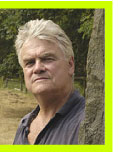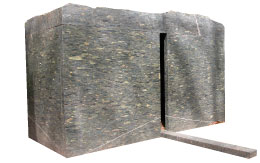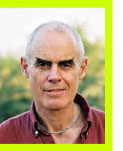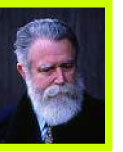This section gives you background details to the featured artists to support your learning. Additional material may be found in the “Links” section.
Stephen Cox (b. 1946, UK)
Stephen Cox comes out of the minimalist tradition. Since the 1970s he has made sculptures out of stone, and has been deeply inspired by the stone carvings of earlier times. His work carries a sense of the histories and traditions of stone carving from different times and from different parts of the world. He is well known for working with unusual stones and stones that are extremely difficult to carve.
 Initially he worked in Italy, inspired by the bas-reliefs of
Initially he worked in Italy, inspired by the bas-reliefs of  Agostino di Duccio the 15th century Renaissance sculptor.Later, he visited a village in India, which was an ancient centre for traditional Indian temple carving using Indian granite. He subsequently worked with the local stone carvers, setting up his own studio there, and making work inspired both by their work and by the forms of the local fishing boats.
Agostino di Duccio the 15th century Renaissance sculptor.Later, he visited a village in India, which was an ancient centre for traditional Indian temple carving using Indian granite. He subsequently worked with the local stone carvers, setting up his own studio there, and making work inspired both by their work and by the forms of the local fishing boats.
Later still he reopened a 4,000 year-old porphyry quarry in Egypt, in order to make works for the New Opera House in Cairo.
Interior Space
His recent works are monumental in character and include a series that have been inspired by tombs and tomb culture. A particular feature of his work is to leave part of the stone in its natural or semi-finished state, perhaps in homage to the generations of people who quarried such stone.
Richard Long (b. 1945, UK)
Richard Long’s work is inspired by his personal, direct experience of the landscape through the activity of walking. Examples of his walks are:
• A 134 mile meandering walk in Scotland
• From the Atlantic shore to the Mediterranean shore. A 560 mile walk across Portugal and Spain
• A ten day walk on the Rio Grande (Mexico)
• A sixty minute circle walk on Dartmoor
Full Moon Circle
 He records these walks through a series of simple activities
He records these walks through a series of simple activities  that arise
that arise
from a deep personal connection with the landscape. For example, one walk, over 2 1⁄ 2 days in Ireland, was determined by throwing one stone 3,628 times and each time walking to the place where it landed, picking it up and throwing it again. Other walks are recorded:.
• by the sounds or the changes in wind direction at regular points
• by making cairns • by walking in predetermined circles or straight lines
• by picking up found objects and carrying them a certain distance, only to replace them with a new object
The final work is minimal: a map, or a few words or symbols on the gallery wall which briefly record his relationship with the landscape that he has encountered.
Anne Seymour says of his work:
“His work seems steeped in intention to keep all the channels of sensitivity open, to experience things as immediately and as keenly as possible, so that by simply remaining true to nature he will by natural means extend his explorations deeper and deeper into the nature of reality itself.”
Richard Long’s sculptures are made by arranging natural materials, usually stone or wood, into a shape on the floor or ground: circle, line, spiral or cross. He says:
“All I’m saying is I’m just putting that stone on the ground, though obviously I realise it’s never as simple as that. But my works should be completely self-contained, they shouldn’t need any explanations or references, they should be things or ideas in their own right. They should have a life of their own and take their chances.”
James Turrell (b. 1943, US)
 James Turrell works with light and space. He has held a pilot’s licence
James Turrell works with light and space. He has held a pilot’s licence
since the age of 16 and his visual experiences whilst flying have greatly influenced his work.
He creates spaces which enable the viewer to study particular qualities and variations in the light that is all around us, that we often take for granted. In 1977 he embarked upon a huge project at Roden Crater in Arizona USA, transforming the extinct volcano into a vast observatory. The rim has been reshaped to an even bowl, so that from inside the crater the sky is seen as a giant dome. It has underground tunnels and chambers in which visitors can experience the particular qualities of the light of, for example, the moon and Venus. He says:
Skyspace
“I wanted to build these spaces that engage celestial events, kind of making music with a series of light.”
He has worked in galleries, building spaces and lighting them in a way that breaks down the viewer’s preconceptions about the relationship between light and space, and creates a sense of wonder at the way in which we perceive light and colour.
He has also created a series of sky spaces, each one a particular context for viewing the sky. Light and colour is perceived by each person uniquely, and in this way we each contribute to our individual experience of these spaces.
“I would just like to take you and put you in front of (this mountain) in a way you couldn’t miss it. It’s all that I can hope for and that way there is a possibility that the same kind of delight of seeing that happens to me, could happen to you.” Skyspace Full Moon Circle Interior Space